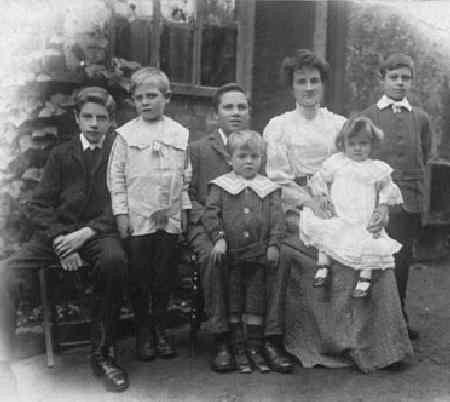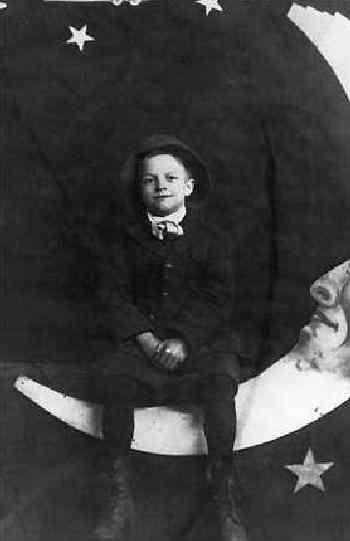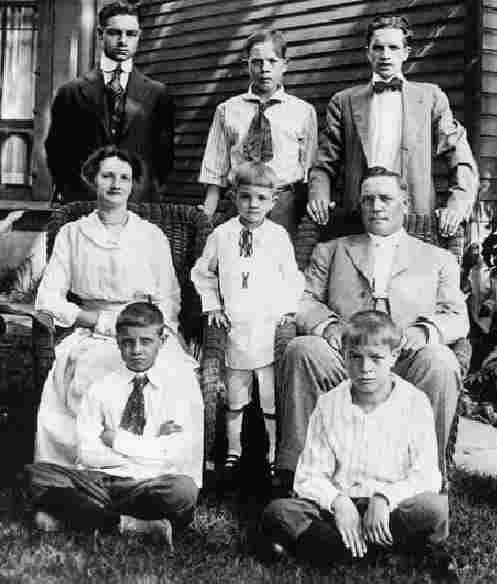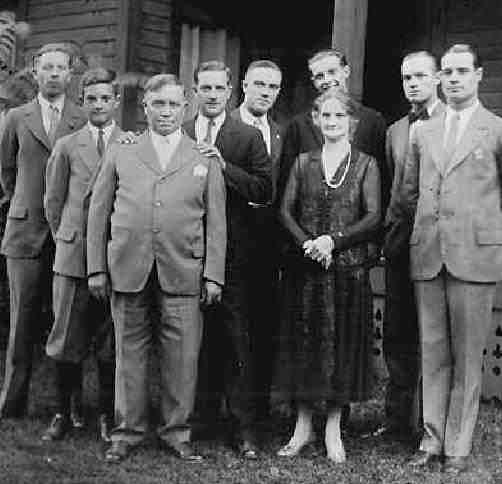
Biographical Details on Boys' Clothing Styles: Bob Hope (1903- )

Figure 1.--This is the Hope family in 1907. It looks to have been taken just before the family emmigrated to Anerica. The phptographer A.E. Golding was in St. George. Bob or Leslie at the time is the little boy in the middle. Note that the older boys wear long pants, but not Eton collars.
|
English born Bob Hope grew up in America. Bob was the fifth of seven sons. He was born Leslie Townes Hope in Eltham, England on May 29, 1903. His English father, William Henry Hope, was a stonemason--his Welsh mother Avis Townes Hope, an aspiring concert singer. Leslie's father in 1907 brought his family to Cleveland, Ohio. Bob went one to become perhaps America's most beloved comedian. The boys were dressed in a variety of juvenile suits with large collars when then they were little. In America they wore knickers although they wore long pants in England. As a youth he earned spending money selling newspapers and was a constant entrant in amateur talent shows. During his years at East High School he worked as a delivery boy in his brother Fred's meat market. He was also a soda jerk, a shoe salesman, and a pool hustler. After high school, Bob took dancing lessons from entertainer King Rastus Brown and from vaudeville hoofer Johnny Root. A natural, he took over some classes for his teachers. Bob also worked briefly as a newspaper reporter and tried amateur boxing under the name of Packy East before beginning his famed show business career in Vaudeville.
Parents
Bob Hope's English father, William Henry Hope, was a stonemason. His Welsh mother Avis Townes Hope, was an aspiring concert singer. Presumably she helped to inspire Bob's interest in show business.

Figure 2.--This photograph of Bob looks to have been taken about 1908. The tunic suit and barefeet looks more American than the 1907 family portrait.
|
Birth
English born Bob Hope grew up in America. He was born Leslie Townes Hope in Eltham, England on May 29, 1903.
Brothers
Bob was the fifth of seven sons. Presumably after the first few boys, Bob's mother kept trying in the hope of at leasr one little girl.
America
Leslie's father in 1907 brought his family to Cleveland, Ohio when Bob was only about 4 years old. He went one to become perhaps America's most beloved comedian. Few unless they had read about him knew that he was born in England. His father became a naturalized U.S. citizen whichb at the time made Leslie, soon to be known to most Americans as Bob, and his six brothers U.S. citizens.
There is some disagreement as to just when this naturalization took place. One source dates the naturalization as December 20, 1920. Brian Morgan who is reserching geneologocal records has contacted HBC to inform us that The Public Records Office in Ebgland indicates that the naturalization took place in Cleveland during 1913. Hope attended Fairmount Grammar and Junior High Schools in Cleveland. During his years at East High, he worked as a delivery boy, a soda fountain clerk, and a shoe salesman.

Figure 3.--Bob's interest in theatriclas began at an early age. Here he wears above the knee knickers with long dark stockings about 1911. He was 8 years old.
|
Clothes
As babies the boys wore dresses. The boys were dressed in a variety of juvenile suits with large collars when then they were little. In America they wore knickers although they wore long pants in England.
Headwear
No information is available on hats and caps.
Dresses
As infants the boys wore dresses, a common fashion in the late 19th and early 20th century.
Juvenile suits
The boys in England wore a variety of juvenile kneepants outfits. They appear to have sailor styling, but were not the traditional styling of standard sailor suits.
Tunic suits
A photograph of Bon in about 1908 show him wearing a standard white belted-tunic suit with knicker-style pants. The photograph appears to be taken during the summer, despite the long sleeves, as he is barefoot.
Eton collars
Only one of the Hope brothers wears an Eton collar in 1907 (figure 1). The older brothers wear long pants and what look to be soft collar shirts. Only the middle brother wears an Eton collar woth what looks to be a knickers Norfolk suit. The younger boys wear a variety of more juvenile collars.
Knickers
The older boys as young teenagers in England wore long pants. In America the boys at the same age wore knickers. I'm not sure about this difference. Presumably their mother was just following the differing styles for boys wear in Britain and America. This suggests that American boys more commonly wore knickers than British boys who seem to have more commonly worn long pants by their early teen years. The boys wore both over the knee and below the knee styles of knickers.

Figure 4.--The two boys in front wear knickers and long dark stockings. Note the one boy wears a shirt waist without a collar. The youngest boy wears a white kneepants outfit weith white socks and strap shoes. The photograph was taken in 1916 when Bob was about 13 years old.
|
Long pants
The two older boys in England wore long pants suits. Once they movded to America the boys as teenagers wore knickers. This suggests that long pants were being more commonly worn by English boys than American boys, although the chronological period may also be a factor. Thus is interesting given the fact that in later years British boys more commonly wore short pants than American boys.
Hosiery
The boys in knickers and kneepanrs isually wore dark long stockings. One photograph in England shows Bon wearin fark short socks. In Anerica they would go vbarefoot during the summer. One 1916 photograph shows the youngest boy wearing three-quarter length white stocks. Mostly they wore long stockings. I do not see any kneesocks.
Shoes
The younger boys sometimes wore strap shoes. One 1916 photograph shows the youngest boy wearing double-bar strap shoes. The other shoes look to be mostly high-top styles.
Hair Styles
As infants still in dresses, the boy wore long hair. By the time they were breeched, however, they had short hair. The hair was often done in bangs, even as young teenagers.
Teen Years
As a youth he earned spending money selling newspapers and was a constant entrant in amateur talent shows. During his years at East High School he worked as a delivery boy in his brother Fred's meat market. He was also a soda jerk, a shoe salesman, and a pool hustler. After high school, Bob took dancing lessons from entertainer King Rastus Brown and from vaudeville hoofer Johnny Root. A natural, he took over some classes for his teachers. Bob also worked briefly as a newspaper reporter and tried amateur boxing under the name of Packy East before beginning his famed show business career in Vaudeville.

Figure 5.--Notice that the younest Hope brother still wears a knickers suit with long stockings. Bob is second from the right. The photograph was probably taken about 1922.
|
Career
After high school, Bob took dancing lessons from entertainer King Rastus Brown and from vaudeville hoofer Johnny Root. A natural, he took over some classes for his teachers. Bob also worked briefly as a newspaper reporter and tried amateur boxing under the name of Packy East before beginning his famed show business career in Vaudeville. Many Vaudville performers, like Hope, were recent emigrants who saw a vaudeville career as one of the few
ways to succeed as a "foreigner" in America. Bob made his show business debut in 1924 in a dancing act with partner Lloyd Durbin in a Fatty
Arbuckle Revue. Throughout his extraordinary professional career of nearly 70 years, Bob practiced the rotiens he learned in vaudeville and perpetuated variety entertainment traditions in stage musical comedy, motion pictures,
radio, and television. Despite all those performances, he is perhaps best remembered for the countless the live appearances he made around the world with the USO in support of American armed forces. The USO shows began in World War II and continued through the Viernam War.
Christopher Wagner

Navigate the Boys' Historical Clothing Biography pages:
[Return to Main Biography page]
[Biographies A-F]
[Biographies G-L]
[Biographies M-R]
[Biographies S-Z]
Navigate the Boys' Historical Clothing Web Site:
[Introduction]
[Activities]
[Biographies]
[Chronology]
[Clothing styles]
[Countries]
[Bibliographies]
[Contributions]
[FAQs]
[Glossaries]
[Satellite sites]
[Tools]
[Boys' Clothing Home]
Created: July 7, 2001
Last updated: March 21, 2002







